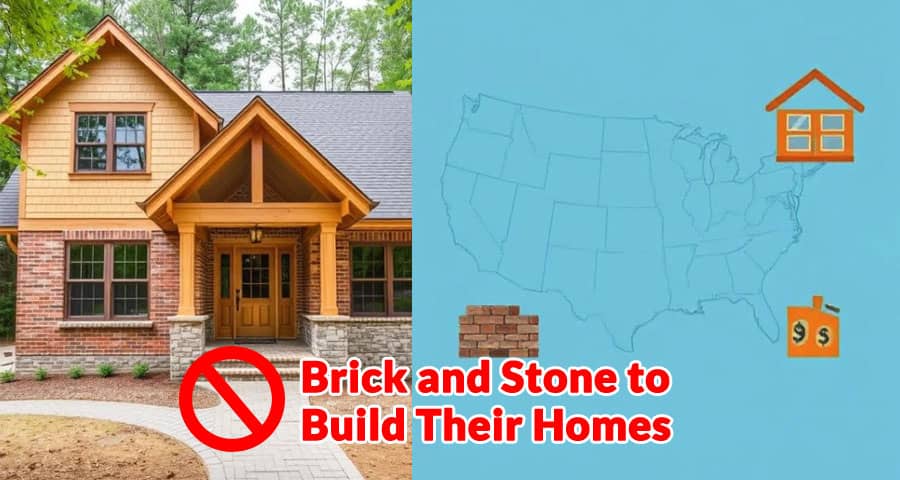Why Don't Americans Use Brick and Stone to Build Their Homes?

In the United States, brick and stone homes are far less common than in many other parts of the world. While materials like wood and vinyl siding dominate the residential construction landscape, brick and stone remain a niche choice. Understanding why this is the case requires exploring factors such as cost, availability of materials, climate conditions, and cultural preferences.
Historical Perspective on American Home Construction
Historically, early American settlers built homes with materials that were readily available. In regions where forests were abundant, wooden structures became the default choice. Conversely, areas with limited timber, like parts of the Northeast, saw more brick and stone homes.
Additionally, the growth of the railroad network in the 19th century made the transportation of lumber easier, further encouraging the widespread use of wood. This historical reliance on wood has persisted, shaping the modern American construction landscape.
Material Costs and Affordability
One of the primary reasons why brick and stone are not as commonly used in American home construction is their higher cost compared to wood. While brick and stone offer longevity and durability, the upfront expenses for these materials are significantly greater.
- Brick installation can cost between $15 to $30 per square foot.
- Stone veneer, while more affordable than natural stone, still ranges from $25 to $50 per square foot.
- Wooden construction remains significantly cheaper, costing around $10 to $20 per square foot.
These cost differences make wood a more appealing option for builders and homeowners aiming to keep construction budgets manageable.
Construction Speed and Labor
Building with brick or stone is a labor-intensive process. Skilled masons are required to ensure proper installation, which increases labor costs and extends construction time. On the other hand, wood-framed homes can be built using prefabricated materials and modular construction techniques, leading to faster and more cost-effective builds.
Moreover, framing crews working with wood are more readily available compared to specialized masons, further contributing to the prevalence of wood-framed homes.
Regional Climate and Environmental Factors
Climate plays a major role in determining the materials used in construction. While brick and stone are highly durable and offer excellent fire resistance and energy efficiency, they are not always ideal for all environments.
- In regions prone to earthquakes such as California, brick and stone homes are at greater risk of structural damage compared to flexible wood-framed structures.
- Areas with extreme temperature fluctuations can also pose challenges. Stone and brick can expand and contract, causing cracks over time.
- In the southern U.S., the heat retention of stone and brick can make homes uncomfortably warm, leading homeowners to prefer wood or stucco.
Cultural Preferences and Aesthetic Trends
American homebuyers often favor the traditional wooden siding or vinyl-clad exteriors for their aesthetic appeal. Styles like Colonial, Craftsman, and Ranch homes are commonly associated with wood-framed construction.
Furthermore, in many suburban areas, developers tend to standardize the construction process, creating neighborhoods with similar-looking homes that utilize materials like wood and vinyl siding to reduce costs and maximize efficiency.
Sustainability Considerations
While stone and brick are long-lasting and offer excellent insulation properties, the production of these materials can be resource-intensive. Brick manufacturing involves significant energy consumption and CO2 emissions.
On the other hand, sustainably sourced wood can serve as a more environmentally friendly option. Many builders are adopting engineered wood products and composite materials that offer strength and durability while reducing environmental impact.
Insurance and Maintenance
Homeowners' insurance rates can also influence material choices. While brick and stone homes often qualify for lower insurance premiums due to their fire-resistant properties, the higher initial cost may outweigh the long-term savings.
In contrast, wood-framed homes typically have higher maintenance requirements due to issues like rot, termite damage, and weathering. However, regular maintenance and modern treatments can mitigate these issues.
Future Trends in American Home Construction
As construction technology advances and more emphasis is placed on sustainable practices, we may see an increase in the use of alternative materials. Brick veneers and stone cladding are becoming popular, providing the aesthetic appeal of traditional masonry without the associated costs and labor.
Additionally, as energy-efficient construction methods and innovations like insulated concrete forms (ICFs) and modular construction gain traction, brick and stone could see a resurgence in specific regions.
Conclusion
While brick and stone homes are less common in the U.S. compared to wood-framed structures, they remain a desirable option for those seeking durability, aesthetic appeal, and fire resistance. Factors such as cost, labor availability, and regional climate will continue to shape material choices in American home construction.
Ultimately, whether building with wood, brick, or stone, understanding the benefits and limitations of each material is key to making informed decisions.
Please watch the following short video for Why Don't Americans Use Brick and Stone to Build Their Homes?
